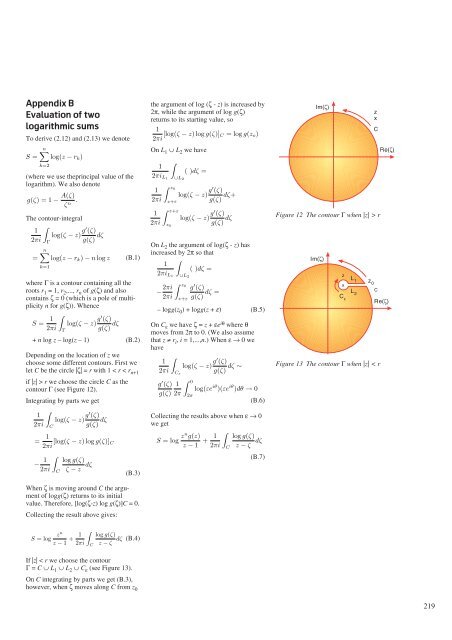Contents Telektronikk - Telenor
Contents Telektronikk - Telenor
Contents Telektronikk - Telenor
You also want an ePaper? Increase the reach of your titles
YUMPU automatically turns print PDFs into web optimized ePapers that Google loves.
Appendix B<br />
Evaluation of two<br />
logarithmic sums<br />
To derive (2.12) and (2.13) we denote<br />
n�<br />
S = log(z − rk)<br />
k=2<br />
(where we use theprincipal value of the<br />
logarithm). We also denote<br />
g(ζ) =1− A(ζ)<br />
.<br />
ζn The contour-integral<br />
�<br />
1<br />
log(ζ − z)<br />
2πi Γ<br />
g′ (ζ)<br />
g(ζ) dζ<br />
n�<br />
= log(z − rk) − n log z<br />
k=1<br />
(B.1)<br />
where Γ is a contour containing all the<br />
roots r1 = 1, r2 ,..., rn of g(ζ) and also<br />
contains ζ = 0 (which is a pole of multiplicity<br />
n for g(ζ)). Whence<br />
S = 1<br />
2πi<br />
�<br />
Γ<br />
log(ζ − z) g′ (ζ)<br />
g(ζ) dζ<br />
+ n log z – log(z – 1) (B.2)<br />
Depending on the location of z we<br />
choose some different contours. First we<br />
let C be the circle |ζ| = r with 1 < r < r n+1<br />
if |z| > r we choose the circle C as the<br />
contour Γ (see Figure 12).<br />
Integrating by parts we get<br />
�<br />
1<br />
log(ζ − z)<br />
2πi C<br />
g′ (ζ)<br />
g(ζ) dζ<br />
= 1<br />
[log(ζ − z)logg(ζ)]C<br />
2πi<br />
− 1<br />
�<br />
log g(ζ)<br />
2πi ζ − z dζ<br />
C<br />
(B.3)<br />
When ζ is moving around C the argument<br />
of logg(ζ) returns to its initial<br />
value. Therefore, [log(ζ-z) log g(ζ)]C = 0.<br />
Collecting the result above gives:<br />
S =log zn<br />
�<br />
1 log g(ζ)<br />
+<br />
z − 1 2πi C z − ζ dζ<br />
(B.4)<br />
If |z| < r we choose the contour<br />
Γ = C ∪ L1 ∪ L2 ∪ Cε (see Figure 13).<br />
On C integrating by parts we get (B.3),<br />
however, when ζ moves along C from z0 the argument of log (ζ - z) is increased by<br />
2π, while the argument of log g(ζ)<br />
returns to its starting value, so<br />
1<br />
2πi [log(ζ − z)logg(ζ)]C =logg(zo)<br />
On L 1 ∪ L 2 we have<br />
�<br />
1<br />
()dζ =<br />
2πiL1 ∪L2<br />
� z0<br />
1<br />
log(ζ − z)<br />
2πi z+ε<br />
g′ (ζ)<br />
g(ζ) dζ+<br />
� z+ε<br />
1<br />
log(ζ − z)<br />
2πi<br />
g′ (ζ)<br />
g(ζ) dζ<br />
z0<br />
On L2 the argument of log(ζ - z) has<br />
increased by 2π so that<br />
�<br />
1<br />
()dζ =<br />
2πiL1 ∪L2<br />
− 2πi<br />
� z0<br />
g<br />
2πi<br />
′ (ζ)<br />
dζ =<br />
g(ζ)<br />
z+ε<br />
– logg(z 0 ) + logg(z + ε) (B.5)<br />
On Cε we have ζ = z + εeiθ where θ<br />
moves from 2π to 0. (We also assume<br />
that z ≠ ri , i = 1,...,n.) When ε→0 we<br />
have<br />
�<br />
1<br />
log(ζ − z)<br />
2πi Cε<br />
(B.6)<br />
g′ (ζ)<br />
dζ ∼<br />
g(ζ)<br />
g ′ � 0<br />
(ζ) 1<br />
log(εe<br />
g(ζ) 2π 2π<br />
iθ )(εe iθ )dθ → 0<br />
Collecting the results above when ε→0 we get<br />
S =log zn �<br />
g(z) 1 log g(ζ)<br />
+<br />
z − 1 2πi C z − ζ dζ<br />
(B.7)<br />
Im(ζ)<br />
z<br />
x<br />
Figure 12 The contour Γ when |z| > r<br />
Im(ζ)<br />
z<br />
x<br />
C ε<br />
L 1<br />
L 2<br />
Figure 13 The contour Γ when |z| < r<br />
C<br />
z 0<br />
C<br />
Re(ζ)<br />
Re(ζ)<br />
219

















